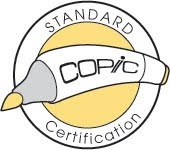 Standard Certification Classes 2011, North America
Standard Certification Classes 2011, North AmericaThere are a few Papercrafting Certification classes in the next two months, but you won't see March or April classes on the calendar for another couple weeks. If you have questions about the program you can e-mail Nancy, nancy@copicmarker.com for more info.
Jan. 16 Phoenix AZ taught by Jennie Black Open to Public
Jan. 28 Los Angeles, CA (CHA) taught by Jennie Black Open to Public
Intermediate Certification Classes 2011
We still have plenty of space in the Intermediate class, so don't be afraid of applying, as that is bound to be a great class before CHA. These classes are for people who want to take their coloring to the next level. We discuss shading, composition, and coloring more realistically. However, it is important to have mastered basic marker techniques, like blending and feathering.
The purpose of the application is to make sure that we don't have to slow down the class for those who have not mastered basic concepts. However, most people who have been coloring for a couple years and taken the Standard Certification should have no problem passing the test. If this sounds like you and you think this is some great stuff to learn, then go ahead and fill out the application! You probably will make it in.
Jan. 27 Los Angeles, CA (CHA) taught by Debbie Olson & Sherrie Siemens subject to approved application
April, date TBA, Phoenix, AZ taught by Debbie Olson & Colleen Schaan Applications are not available yet
Click here for applications and class details (time/location/fees) for each session. Also, there are lots of classes coming up internationally as well:
International Certifications
UK Certifications
Wendy Kadzidlo, the instructor for UK Certification classes will be teaching a couple classes in the upcoming months.
March 4th – Stevenage, Herts, taught by Wendy Kadzidlo
May 27th – Warrington, Cheshire taught by Wendy Kadzidlo
For information on these classes, please e-mail Wendy: wendy@stampsandmemories.co.uk
Australian Certifications
5 March, Melbourne Beginner Certification - Taught by Mandi
12 March, Sydney Beginner Certification - Taught by Mandi (click here for Australia class info)
Other events
If you are attending Winter CHA in Los Angeles, CA then stop by our booth and check out the new releases. I'll be in the booth the whole week, demoing markers, as will many of our instructors. Next week we'll tell you what some of those releases will be, so stay tuned. Also, each of our instructors teaches classes of their own. Go to their blogs to find out more about their classes in your area and how to register for events. Have a Happy New Year!








